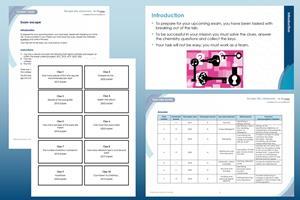Get your post-16 students to have some fun with this escape room activity – and inadvertently revise while doing so

This is a fun, intellectual escape room activity to do with your post-16 students. It’s a simple, but effective revision tool that will help them identify the areas they need to work on in preparation for their final exams.
Materials
In addition to the downloadable resources, you will need one set of the multiple-choice sections of the 2017, 2018, 2019, 2022 and 2023 SQA Higher Chemistry past papers per group – these can be either printed or opened on a digital device. You will also need at least one chemistry data booklet per group.
An ideal group size is four students, but this is entirely down to your judgement. If the Wi-Fi in your setting is temperamental, make paper copies of the past papers available to students, or pre-load the papers onto devices.
To make things more exciting, I have a mini jail cell on my desk containing prizes, and I give the winning group the keys. But this is an optional bit of fun.

Download this
Full set of clues and answers, including guidance on common misconceptions, plus instructions for learners. Choose pdf or editable versions.
Resources include:
How to play
Each puzzle begins with a clue, which is either a general knowledge or chemistry question. The answer to each clue is a number, which corresponds to a multiple-choice question on the past paper noted on the clue card.
First, give each group the first clue: How many pieces of fruit and veg are recommended per day (2019 paper)? With an answer of 5, this leads students to multiple-choice question 5 of the 2019 paper. When students bring you the correct answer for both the clue (5) and the past paper (choice B), give them the second clue. Continue this process until one group of students solves all 16 clues, all 16 past paper questions and are, therefore, the winners!
Why general knowledge first?
Setting the general knowledge clues first encourages all students to participate in the game and play a role in the team from the get-go, regardless of their chemistry knowledge. I have found that this increases students’ confidence and motivates them to try the past paper questions that follow, as they are already caught up in the competitive atmosphere of the classroom.
Past paper questions
The past paper questions from each sub-section are carefully selected to represent either the style of exam questions that frequently appear in past papers, or questions which assess skills that students find hard to apply. Although no practical skills are required in the game, skills and problem-solving questions do feature. The full breakdown of topics covered, including the specific areas assessed and common mistakes or misconceptions can be found in the downloadable resource, teacher notes.
Extend the fun
The simplicity of this resource means you can run it in its entirety or easily shorten it, depending on the class time you have available. If you wish to use it at any point during the year, you can remove clues or questions relating to any topics not yet covered. You can also use this resource as a quirky retrieval introduction for new classes to allow them to self-assess and reflect on how much of the previous year’s knowledge they have retained.
Downloads
Exam escape student sheet
Handout | PDF, Size 0.15 mbExam escape teacher notes
Handout | PDF, Size 0.19 mbExam escape presentation
Presentation | PDF, Size 0.23 mbExam escape student sheet
Editable handout | Word, Size 0.47 mbExam escape teacher notes
Editable handout | Word, Size 0.46 mbExam escape presentation
Presentation | PowerPoint, Size 0.21 mb

Escape the classroom

Be inspired to design an escape room experience for students with these chemistry related puzzles
- 1
 Currently
reading
Currently
reading
Exam escape
- 3
- 4
- 5
- 6
- 7


























No comments yet